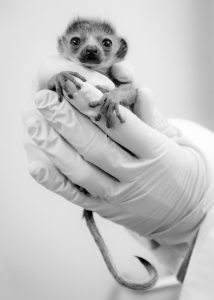
Nacho, a critically endangered mongoose lemur born at the Duke Lemur Center. Photo by Sara Clark.
The Duke Lemur Center is delighted to announce the births of two infants, Bijou and Nacho!
Bijou, a female collared lemur (Eulemur fulvus collaris), was born on April 5, 2017 to parents Odette and Quintin. This gal is notoriously tough to photograph, but our stealthy photographer David Haring finally succeeded in snapping the adorable images below.
Collared lemurs are ENDANGERED in Madagascar. Primary threats include bushmeat hunting, capture for the local pet trade, and habitat loss due to slash-and-burn agriculture (required for traditional rice farming) and burning hardwood trees to produce charcoal. Sadly, the booming charcoal business is contributing to rapid deforestation in Madagascar, endangering many species of lemur across the island.
In response, the DLC’s SAVA conservation program in Madagascar distributes fuel-efficient “Rocket Stoves” to local Malagasy people. These stoves can reduce wood and charcoal use by 50%, which reduces pressure on forest resources and slows forest destruction – and helps not only lemurs but also the Malagasy in the process. (The stoves, in addition to being more fuel efficient, improve women’s and children’s respiratory health through improved kitchen air quality.)
Welcome to the world, little Bijou!
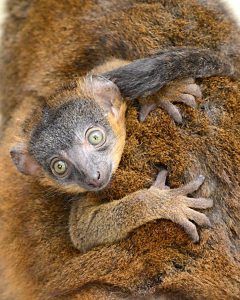
Bijou, an endangered collared lemur. Photo by David Haring.
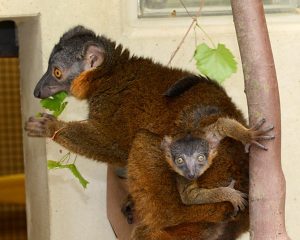
One-month-old Bijou wraps around her mother, Odette. Photo by David Haring.
![]()
Nacho, a male mongoose lemur (Eulemur mongoz), was born to parents Carolina and Duggan on April 4, 2017. Mongoose lemurs are sexually dichromatic in the coloration of their cheeks and “beards”: males have reddish orange fur under their chins, whereas females’ chins are creamy white. Males like Nacho are born with white beards that turn reddish-brown when the infants are 5 to 6 weeks old.
Our lemurs live in a variety of naturalistic settings, most notably in the DLC’s signature Natural Habitat Enclosures (NHEs). Here, they free-range in large tracts of Duke Forest and live in natural social groups. The NHEs aren’t just heaven to lemurs; they’re a delight to researchers too! The 1.5- to 13-acre enclosures give scholars the rare opportunity to observe the same behaviors and social structures that would be observed in wild lemurs, without having to fly halfway around the world to Madagascar. Duke undergraduates and grad a are also able to observe, investigate, and learn from the DLC’s unique “living laboratories” just minutes from main campus.
Nacho free ranges happily in NHE 1 with Carolina, Duggan, and older siblings Oscar and Bonita. As an infant, he’s learning good free-ranging behavior from Carolina before growing up, gaining independence, and bounding off on his own. For now, he clings snugly to momma’s back as she springs through the verdant forest.
Sadly, mongoose lemurs are CRITICALLY ENDANGERED in their native Madagascar. Similar to the collared lemur, primary threats include bushmeat hunting and habitat loss due to slash-and-burn agriculture and charcoal production. Click here to read more about how infants born at the DLC form a genetic safety net for species facing extinction in the wild.
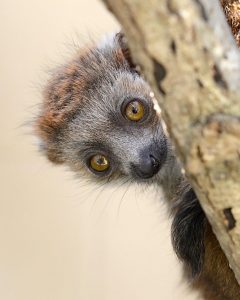
One-month-old Nacho, riding his mother’s belly, peeks out from behind a branch. Photo by David Haring.

Nacho and Carolina free-range in one of the DLC’s signature Natural Habitat Enclosures. Photo by David Haring.
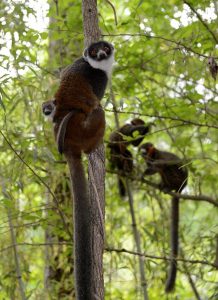
Nacho and Carolina, father Duggan, and older brother Oscar. Female mongoose lemurs have creamy white chins. Here, Carolina displays hers beautifully! Photo by David Haring.

Nacho and Carolina with Bonita, Nacho’s older sister. Photo by David Haring.

